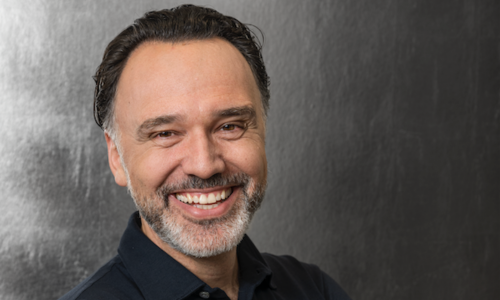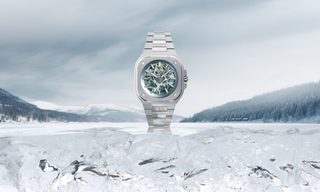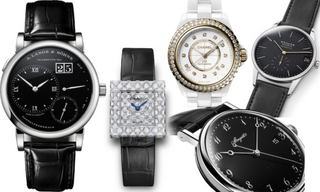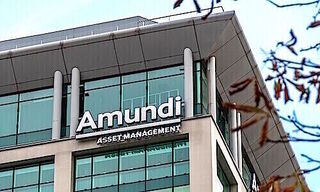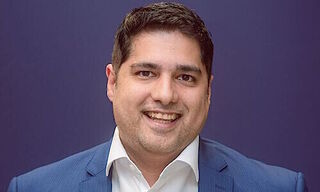In 2011, entrepreneur Oliver Ebstein acquired Chronoswiss, the only Swiss watch brand founded at the height of the watch crisis—a mechanical legacy that continues to be cherished today. During the "Geneva Watch Days" exhibition, finews.ch caught up with the boutique watchmaker to discuss new technologies, the state of the industry, and his relationship with his bank.
Mr. Ebstein, you grew up in the Canton of Zurich and have been living in Central Switzerland for decades. Chronoswiss is based in Lucerne, far from the hotspots of the rest of the watch industry.
Don’t be mistaken... Lucerne has a rich watchmaking history. Until a few years ago, it was one of the three most important cities for watch sales, alongside Paris and Hong Kong. There have always been jewelers here who made watches themselves—Bucherer, of course, or Jörg Spöring, who designed the famous Türler clock. Today, we are working with his son.
And that's why you moved the manufactory to Lucerne after acquiring the brand?
In addition, an important reason was that we operate in the luxury sector. For me personally, the greatest luxury is being able to live and work where I feel at home.
Where does your interest in mechanical watches come from?
I've been a fan of watches since I have been a child. When I was about seven or eight years old, I visited the Basel Jewelry Fair with my parents. The enormous booths, some of them two or three stories high, left a huge impression on me. My parents ran an import-export business for accessories and jewelry. While they were meeting with suppliers and customers at the fair, I would go around collecting catalogs. Back then, catalogs were still a big thing (laughs).
«For me personally, the greatest luxury is being able to live and work where I feel at home.»
So, decades later, after having built a career in finance and pharmaceuticals, were you searching for a watch brand to purchase?
No, it was actually a coincidence! A colleague approached me and mentioned that Gerd-Rüdiger Lang (1943-2023), the founder of Chronoswiss, was looking for a successor. He asked, «You know Chronoswiss and even own a 'Regulator'—should I connect you with Mr. Lang?» This was in 2011. So, I traveled to Munich to meet Mr. Lang, and we spent hours discussing everything from life to watches.

Art of modernen Mechanics: Chronoswiss Movement. (Image: zVg)
Unfortunately, his daughter, a master watchmaker who had grown up in the company for thirty years, had canceled just before the transfer of the business. Lang was adamant about not selling his life's work to a large corporation that was only interested in the name, would turn the product around three times, and in the end, nothing would remain. Lang was also in talks with another interested party, so everything had to happen quickly. It was a spontaneous, last-minute situation.
What happened next?
Within two weeks, I had to decide whether I wanted to turn my passion and hobby into a profession. Following this decision, there were a few more weeks of due diligence, and the sale was announced at the Basel Watch Fair.
What fascinated you about Chronoswiss?
Chronoswiss is the only watch company that was founded during the quartz crisis. In the late 1970s and early 1980s, Japanese manufacturers flooded the market with battery-operated movements.
Initially, the Swiss thought this would be a passing phase, but that wasn’t the case. About 50 to 60 percent of the watch industry went bankrupt. Gerd-Rüdiger Lang, who had been working for Heuer, was also affected. He was told, «We like you, but you have to leave. Here’s a box with old movements and spare parts.» This box became his last paycheck and the foundation for Chronoswiss, which he and his wife started in a garage.
«Chronoswiss watches looked completely different from anything that had been seen up to that point.»
He always said: «I’m not going to repair battery-operated watches!» Alongside Nicolas G. Hayek and Jean-Claude Biver Lang was probably the only one who still believed in the future of mechanical watches at that time. Chronoswiss thus became a particularly innovative brand in the technical field.
In what way?
Chronoswiss watches looked completely different from anything that had been seen up to that point The «Regulator» featured a dial design previously known only from wall clocks, not wristwatches. Moreover, Chronoswiss was the first manufacturer to open the case back and insert a glass panel, allowing a view of the movement. To this day, we have not produced a single watch with a closed case back. For me, Chronoswiss represents the renaissance of mechanical watchmaking.
It is often mentioned that after the acquisition, you repatriated production from Germany to Switzerland.
This is not entirely accurate. Chronoswiss always had a company in Switzerland responsible for the movements and procurement. The German entity facilitated easier access to the EU market at that time. We then renamed the Swiss company Chronosa to Chronoswiss and relocated everything to Lucerne.
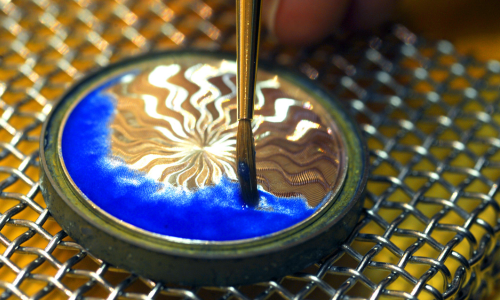
Craft Tradition: Enameling. (Image: Chronoswiss, zVg)
In the German-speaking part of Switzerland, you are one of the very few manufactures that can actually be visited. Is this proving successful?
More and more. Word has gotten around, and we are now featured in some tourist brochures. We are not interested in large tour buses, but we do cater to historically and technically interested watch enthusiasts. And we are very pleased with our presence in Lucerne, we have many American clients who know us, as well as many from the Middle East.
«In Switzerland, we account for about eight percent of our sales.»
Do these visitors also purchase watches directly from you?
Yes. About one in two finds something and buys it directly. The beauty of this is that they meet the people who made their watch: the watchmaker, the person who guillochéd the dial, the one who applied the enamel. This gives the watch a personal, familial touch.
Five years ago, you told the magazine «Bilanz» that you sold around 1,500 watches annually. Is this still accurate?
More or less, yes. We have ventured into somewhat more complex model worlds, making now slightly more expensive watches with more craftsmanship and more enamel. We grow a bit each year. As a family-owned business, it is important to me that we grow steadily and healthily. I try to avoid fleeting trends. There has been a huge rush on certain watches in recent years. This is cooling down now, especially in China.
So you are primarily growing through higher positioning?
Yes. Another lever is that we try to bring the jewelers who carry Chronoswiss closer to the brand by offering them tours, events, and training to better understand our philosophy. This requires bringing them to the manufacture once.
What percentage of your watches do you sell in Switzerland?
About eight percent.
Where do you have the best network of jewelers and dealers?
Our largest market is the DACH region, where we have been active the longest. This is followed by the USA, where we have grown quite well, and the Middle East with Dubai, Abu Dhabi, and Kuwait and he third major market for us is Japan.
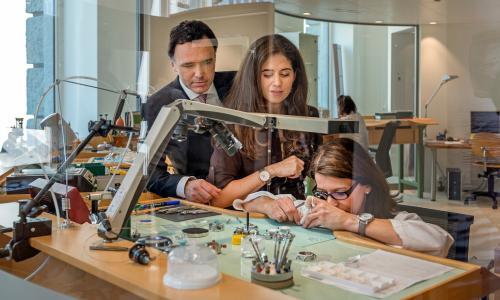
Company Purchased in 2011: The Ebstein Couple, Oliver and Eva-Maria. (Image: Chronoswiss, zVg)
What Do You Aim to Represent with Chronoswiss Watches?
We have always strived to maintain a consistent theme: connecting a Chronoswiss from 1980 with a contemporary model. For this reason, we have retained features like the onion crown. However, we also incorporate modern touches. Our philosophy, «Modern Mechanical». On one hand, we use traditional craftsmanship such as enamel work and century-old machines. On the other hand, we employ cutting-edge materials and techniques.
«The case undergoes a bath and is then coated with a transparent, colored layer, resembling honey..»
In October, for example, we will unveil a special edition of the «Delphis» with its case made from ITR2, a nanotube carbon that looks like crystal but can be drilled, offering exciting design possibilities. The case undergoes a bath and is then coated with a transparent, colored layer, resembling honey, creating a true «Unicorn»in our collection!
You are very modern and bold with your use of colors.
Yes, life is colorful. However, I aim to select colors that can be worn for 20 or 30 years. It’s not about color for the sake of color—it must also tell a story. One of our models pays homage to Paraiba, the green Brazilian gemstone. We also have striking blue watches with a special coating.
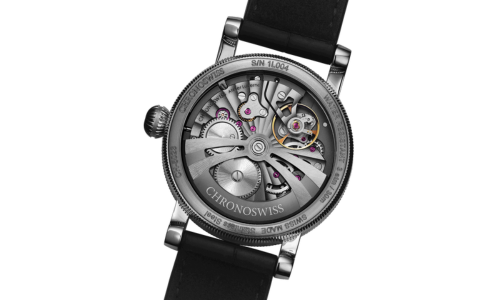
With Onion Crown: Model «StrikeTwo». (Image: Chronoswiss, zVg)
This year, we are also presenting classic colors with the new «Strike»-Family: anthracite, gold, and a model in dark blue with silver. We enjoy working with special techniques such as plasma or vacuum coating. One of our partners for the colors primarily serves the Medtech industry. This definitely reflects the technologically innovative side of Chronoswiss.
What major innovation are you showcasing this fall?
With our «Psycho» Tourbillon, we present one of the most complex and daring timepieces in this color combination from our entire collection. The flying tourbillon at 6 o'clock, combined with a hand-guillochéd dial that can change its color due to the unique chemical coating, demonstrates how we balance traditional craftsmanship, top-notch watchmaking, and modern design. Limited to only 15 pieces, this watch is already almost sold out.
«Despite the challenging market conditions, we have every reason to be optimistic.»
What do events like the Geneva Watch Days bring to you?
As a small company, we always have to consider what is feasible and what the budget allows. Such events are important for maintaining relationships with existing customers and making new contacts. The large brands have the resources and the funds to host their own events and fly in all their partners. For us, it's convenient when everyone is in one place at the same time. It's also better for the jewelers; otherwise, they would spend four months a year traveling.
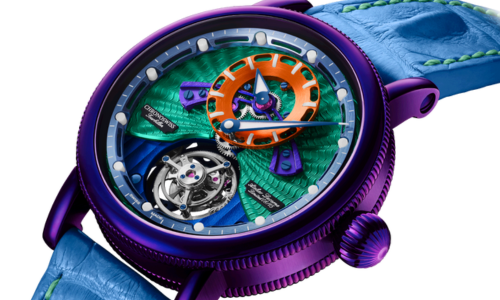
Innovation: «Psycho»-Tourbillon. (Image: Chronoswiss, zVg)
Many in the industry complain about a difficult market situation. What is your experience?
Despite the challenging market conditions, we have every reason to remain optimistic. Although some countries, particularly China, are currently underperforming—just like us—others are either at last year's levels or even better. We have the advantage of producing limited series of 50 pieces for a specific clientele, sometimes even 100 pieces. It’s a different story when you produce tens of thousands of watches and have to sell them.
Do you maintain connections with the financial industry, for example, through your manufactory tours?
We have done it before, but not enough (laughs). As a company, we work with the Luzerner Kantonalbank as our main bank. I also find banking and finance very interesting. However, the daily business takes up so much time that I can’t focus on it. We were the first to accept cryptocurrencies in 2016.
That was quite early and, considering the «Crypto Valley» in Central Switzerland, certainly beneficial for sales?
Yes. It attracted a new customer base, a new generation. Many people were interested in why we were so open to it. As a small manufacturer, you have to play around with such things and find ways to stand out.
Oliver Ebstein fulfilled his dream of owning a watch brand with Chronoswiss erfüllt sich Oliver Ebstein in 2012. Prior to this, the trained business economist worked in the pharmaceutical industry, managing contract manufacturing projects in Switzerland and Romania. He is married and has two daughters.

